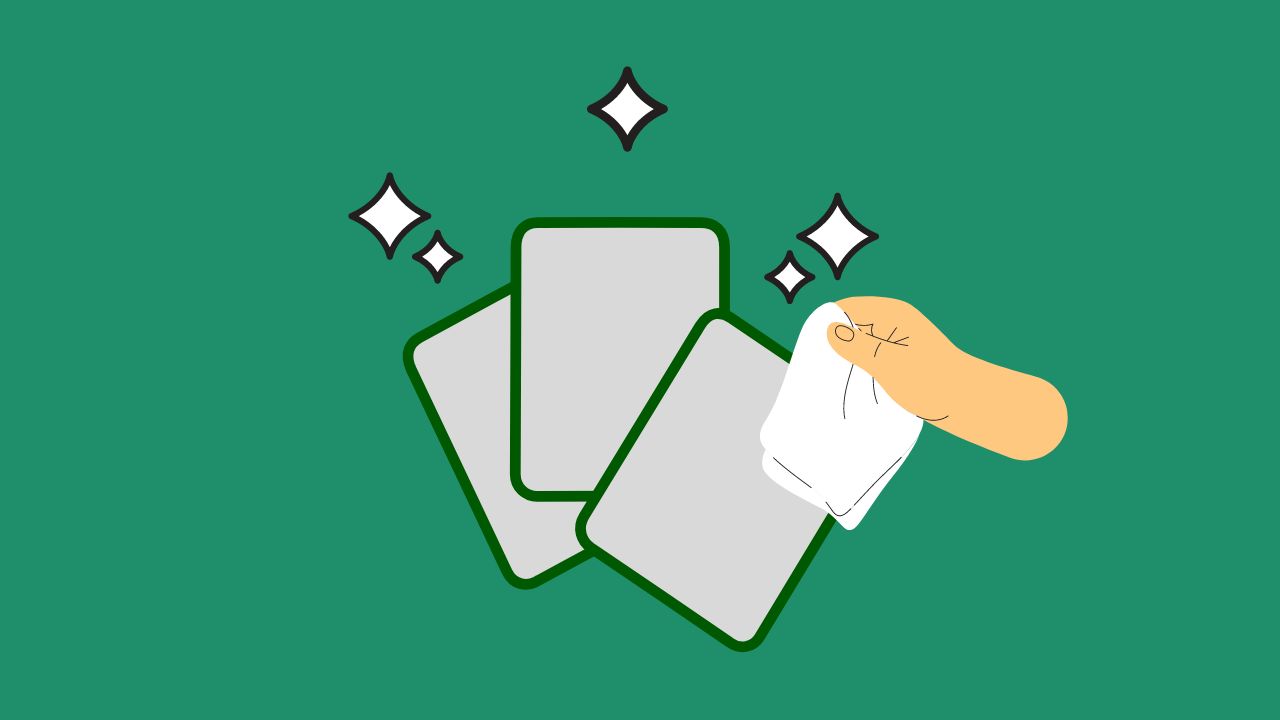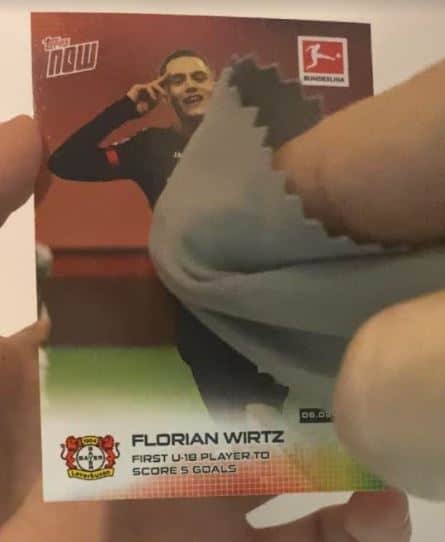
It should be standard practice to give cards a surface clean before grading submission, to help a card achieve its highest possible rating.
Grading companies will grade a card as submitted, meaning they won’t clean cards before a professional inspects the condition. So, it’s best to do that before you send any submissions.
Let’s take a look at the best way to clean and prepare trading cards for higher grading.
Table of Contents
The Best Way To Prepare A Card For Grading
Here’s a quick overview on how to prepare your trading card for grading:
- Carefully remove the card from it’s sleeve and cardholder – wearing gloves or thoroughly cleaning your hands is advised to avoid putting new fingerprints onto the surface of the card.
- Inspect the card under a magnifying lamp to check for dust, smudges or fingerprints.
- Take a microfiber cloth and gently rub the surface on both sides of the card in small circular motions.
- Re-inspect the card under a magnifying lamp to check that the surfaces have been cleaned fully.
- Place the card into a new card sleeve and semi-rigid cardholder.
- Package the card safely, ready for shipping.
Now let’s go into a bit more depth with a step-by-step guide:
Step 1 - Get The Card And Equipment Ready
Before cleaning the trading card that you’re preparing for grading, get everything you need for the process ready to go.
Preparing all the equipment you need before starting will not only make the process more efficient, but will reduce the potential to damage the card by moving around etc.
So, here’s what you’ll need:
- Thoroughly cleaned hands (or gloves): You want to avoid putting any new fingerprints onto the surface. It’s down to personal preference whether to wear gloves or not (there’s mixed opinion on whether it’s a good idea or not). Alternatively, make sure you have clean hands before cleaning your trading card.
- A microfiber cloth: microfiber cloths are primarily used to clean glass surfaces, like sunglasses, but are suitable for trading cards as well. They don’t leave any residue after cleaning which is ideal. Ideally you’ll be able to use a new microfiber cloth.
- A magnifying lamp: I personally like to use a magnifying lamp, for a better view, that is self-mounted and doesn’t require you to hold it while you clean a card. You’ll need both hands free to carefully hold the card in one, while using the microfiber cloth to wipe the surface with the other.
- Card sleeve and semi-rigid cardholder: Once the card is cleaned and ready to be prepared for shipping, it’s important to put it straight into a card sleeve (ideally new) and then a semi-rigid cardholder to preserve its current condition.
Step 2 - Prep The Card For Cleaning
Now it’s time to get the card ready for inspection and cleaning under the magnifying lamp.
If it’s in a card sleeve (which I do recommend) then carefully remove it – at this point you should already have thoroughly washed hands.
Try and avoid touching the surfaces of the card as much as you can. It’s best to hold the card on its edges, with very little pressure (but enough obviously so you don’t drop the card).
The old card sleeve should be kept for other cards etc, but I wouldn’t recommend re-using it for the card you’re preparing for grading – any residue or dust left in that sleeve can negatively impact the card’s grade if you reuse it.
Step 3 - Use A Microfiber Cloth To Clean The Card
So here is where you actually remove any surface imperfections (ie dust and fingerprints) from the card.
At this stage, you should be carefully holding the card on its edges under the magnifying lamp.
Take your microfiber cloth, and gently rub over the full surface of the card on both sides. I recommend a slow circular motion, with enough pressure to remove fingerprints, while also bringing away any dust or residue.
Take the time to pause and inspect the card as you go on areas you’ve wiped, to make sure that no dust or residue is being left behind.

Step 4 - Inspect The Card
Now that you’ve completed the initial clean of the card, it’s time to inspect it fully on both sides to make sure you’ve not missed anything.
A slight fingerprint will likely negatively impact the grade a card gets, so it’s important to check you’ve not missed one.
Grading companies do an initial screening on a card to check the surfaces, but they won’t remove fingerprints for you for liability reasons.
If you notice the card still has some imperfections, then repeat step 3 and do another round of cleaning with the microfiber cloth.
Step 5 - Preserve The Cards Current Condition And Prepare For Shipping
So you’ve inspected the trading card under the magnifying lamp, and you’re happy it’s in the best possible condition to help achieve a higher grade.
Now that the surfaces are spotless and clean, you need to make sure to preserve that current state.
This is where I would take a brand-new card sleeve and carefully put the card into it.
An optional extra, that I like to do, is to place a sticky index tag onto the top of the sleeve (on the outside) before placing it into a semi-rigid cardholder – that makes it easier for the grader to remove the card from the cardholder.
Once that’s done, it’s time to safely package the card for shipping.
Does PSA Clean Cards Before Grading?
No, PSA or any other grading company, do not clean cards before grading.
All cards are graded as submitted, so it’s important you’ve sent the card in its best condition possible if you want it to achieve a high grade.
Taking the necessary steps to properly clean and prepare a card for grading can be the difference between 1 or 2 levels of grade, which can impact its value by thousands of dollars, depending on what card it is.
Do Fingerprints Affect Card Grading?
Yes, fingerprints and any other minor card surface imperfections can have a negative effect on a card’s grade.
As I mentioned before, grading companies generally won’t clean a card that’s been submitted – the card is graded as submitted.
Removing fingerprints and minor surface smudges is not only important to give the card the best chance to be graded higher, but the card will also be enclosed in a plastic casing once it’s been graded, so you don’t want a visible fingerprint on the card to spoil the design.
The only way to clean a card once it’s graded, is to crack open the casing, which would then require the card to be re-submitted for grading.
Can You Fix Damaged Cards?
While you can improve the appearance of a damaged card, you can never fully fix a card that’s been bent, creased, dented or scratched for example.
In other words, once a card is creased or bent, and the fibres of that card are damaged, you’ll never be able to fully restore a card back to its original mint or pristine condition.
Certain measures like heat pressing (with a heat safe cloth over the card to protect the design) can help with creases for example.
However, it’s worth noting that anything you do to restore a card, that isn’t cleaning, can have a further negative effect on it’s perceived condition; Cards that have been restored are highly unlikely to ever achieve a high-end grade.
Should I Wear Gloves When Handling A Trading Card?
There’s mixed opinion among collectors on wearing latex gloves when handling sports cards; I personally don’t, and instead opt for clean hands and careful handling.
But, it doesn’t take much at all to scratch or damage a card’s surface, and worsen its condition (and therefore potential grade) – Sweat or residue from your hands can easily smudge or scratch the design, so some collectors opt for gloves.
It’s best to handle valuable cards, which aren’t enclosed in a casing, as little as possible.
If you do go with gloves, make sure you’re using the right kind to handle cards, you’ll want gloves that don’t have the issue of holding residue or dust.
Should I Clean My Cards Before Grading?
Yes, before submitting any trading card for grading by PSA, BGS, SGC or any other grading company, you should always take the time to surface clean the card.
It’s best practice to clean a card, and then put it into a card sleeve and then a semi-rigid cardholder before submitting for grading – this gives it the best chance of receiving a higher grade, and adding more value to it.


